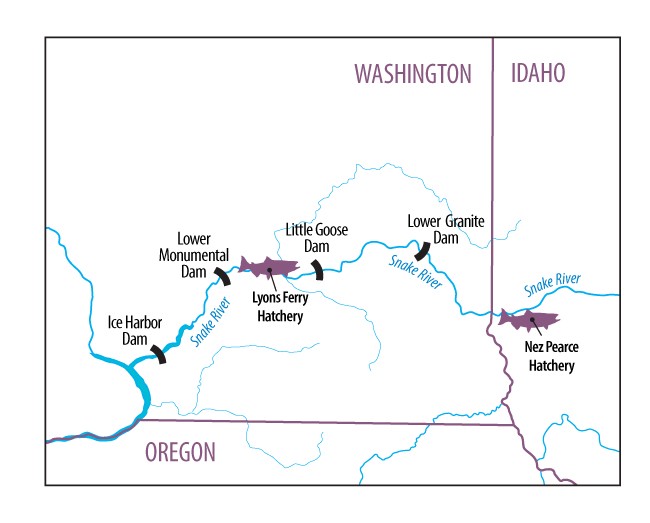Hatchery crews at Lyons Ferry Hatchery in southeast Washington state detected a loss of roughly 249,770 steelhead smolts late last week due to an equipment failure that allowed smolts to escape a rearing pond and make their way into the mainstem Snake River.
Hatchery staff are pursuing better-engineered equipment and will implement increased equipment checks going forward to prevent a similar loss in the future.
This loss accounts for about 64 percent of Lyons Ferry Hatchery’s Wallowa stock summer steelhead production for release in 2022 but less than 8 percent of the overall hatchery steelhead production in the Snake River basin.
Staff became aware of a failure in a rotating screen system and rubber gasket meant to retain fish within a rearing pond when they lowered the water level in late January to collect fish for transport to Cottonwood Acclimation Pond on the Grande Ronde River.
“We share a deep concern alongside anglers and community members for the loss of these steelhead smolts,” said Chris Donley, WDFW’s Eastern Region fishery manager. “We remain committed to pursuing improved equipment and shifting to more frequent servicing to safeguard from equipment failures like this one going forward.”
The gasket, which operates under about 6 feet of water and isn’t readily visible without drawing down the rearing pond, was found to have deteriorated, leaving a 1.5-inch gap between the pond outlet and the rotating screen. Fish opportunistically used this gap to escape the rearing pond into the Snake River. Prior routine assessments to the rotating screen and gasket area didn’t indicate equipment failure or any fish losses. The failed gasket was serviced annually and had been newly installed in August 2021 prior to watering up the pond and populating it with steelhead fingerlings.
The loss of these smolts will likely be undetectable in adult harvest in the mainstem Columbia River and Snake River mixed-stock steelhead fisheries, due to the large number of fish released from facilities above Lower Granite dam and elsewhere in the basin. However, catch and harvest reductions will be detectable in the Touchet River and possibly in the Grande Ronde River, especially in the terminal areas around the acclimation pond release sites.
On Jan. 31 and Feb. 1, hatchery staff transported the remaining 135,230 Wallowa stock steelhead smolts to the Cottonwood Acclimation Pond. These fish will be acclimated there for the remainder of the winter and released into the Grande Ronde River in April. The majority of these smolts will spend one year in the ocean and return to the Columbia basin as adult steelhead in summer or fall of 2023. Fishery managers estimate that the Cottonwood Acclimation Pond release will be 90,000 smolts short of program goals. There will be no Wallowa stock steelhead smolt releases at Dayton Acclimation Pond, or on-station at Lyons Ferry in Spring 2022.
Given current freshwater migratory and ocean survival rates, WDFW fishery managers estimate that enough fish will return to the Grande Ronde River Cottonwood Creek adult trap in spring 2024 to ensure a full egg take. If insufficient numbers of fish return to the trap, WDFW plans to coordinate with Oregon to pursue additional Wallowa stock brood from Oregon facilities farther south in the Grande Ronde basin.
The department operates 80 hatcheries across Washington and raises about 5 million steelhead smolts annually.
Lyons Ferry Fish Hatchery was built in 1982 by the U.S. Army Corps of Engineers as part of the Lower Snake River Compensation Plan. The goal of the program is to restore dam-related losses of steelhead and Chinook salmon. The fish hatchery is named after the family who operated a ferry service in the late 1800s. Lyons Ferry FH is the only LSRCP facility producing Snake River fall Chinook salmon.

